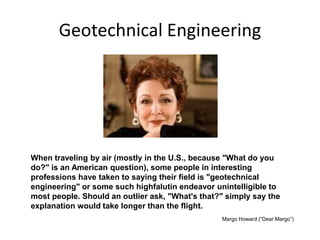The Greatest Guide To Geotheta
The Greatest Guide To Geotheta
Blog Article
The Best Strategy To Use For Geotheta
Table of ContentsThe 9-Minute Rule for GeothetaThe Geotheta StatementsThe Facts About Geotheta UncoveredHow Geotheta can Save You Time, Stress, and Money.Geotheta Fundamentals Explained

They conduct website examinations, accumulate samples, perform lab tests, and examine information to review the viability of the ground for building and construction tasks - Geo Tech Engineer. Based upon their searchings for, geotechnical designers give suggestions for structure layout, slope stability, retaining frameworks, and mitigation of geotechnical threats. They team up with various other specialists, such as architects, structural engineers, and building and construction teams, to make sure that geotechnical considerations are incorporated right into the total task style and implementation
By evaluating the actions and properties of soil and rock, they can determine potential geotechnical risks such as landslides, dirt settlement, or incline instability. Their experience helps prevent failures or crashes that might threaten lives and residential property. Right here are some thorough obligations and duties of a geotechnical engineer: Website Examination: Geotechnical designers conduct website investigations to gather information on subsurface problems.
They analyze the information to recognize the residential properties and actions of the soil and rock, including their strength, leaks in the structure, compaction characteristics, and groundwater conditions. Geotechnical Analysis and Design: Geotechnical engineers evaluate the information accumulated during site investigations to assess the security and suitability of the site for construction projects. They execute geotechnical calculations and modeling to assess aspects such as bearing ability, negotiation, slope stability, lateral earth pressures, and groundwater circulation.
See This Report on Geotheta
Structure Layout: Geotechnical engineers play an essential role in creating structures that can safely support the designated framework. They evaluate the dirt problems and load requirements to identify the suitable structure kind, such as superficial foundations (e.g., footings), deep foundations (e.g (http://prsync.com/geotheta/)., stacks), or specialized techniques like soil enhancement. They think about elements such as negotiation limits, bearing ability, and soil-structure communication to develop ideal foundation styles
They examine construction strategies, screen site tasks, and perform field examinations to verify that the style recommendations are adhered to. If unpredicted geotechnical concerns occur, they assess the circumstance and supply recommendations for removal or changes to the layout. Danger Analysis and Mitigation: Geotechnical designers assess geotechnical risks and risks related to the job website, such as landslides, liquefaction, or dirt disintegration.

Collaboration and Communication: Geotechnical designers function carefully with other specialists associated with a job, such as designers, architectural engineers, and construction groups. Reliable interaction and collaboration are vital to integrate geotechnical factors to consider right into the general task design and building and construction process. Geotechnical designers supply technical proficiency, answer inquiries, and make certain that geotechnical demands are fulfilled.
The Facts About Geotheta Uncovered
Below are some types of geotechnical designers: Foundation Engineer: Foundation engineers concentrate on creating and assessing structures for frameworks. They examine the soil problems, load requirements, and site features to determine one of the most ideal foundation type and design, such as shallow foundations, deep foundations, or specialized strategies like pile foundations.
They examine the variables affecting slope security, such as soil residential properties, groundwater conditions, and incline geometry, and create strategies to stop incline failings and alleviate dangers. Earthquake Engineer: Earthquake engineers focus on examining and creating frameworks to hold up against seismic pressures. They evaluate the seismic hazard of a website, assess soil liquefaction potential, and establish seismic layout requirements to make certain the safety and security and strength of structures during quakes.
They do field testing, gather samples, and analyze the accumulated information to characterize the soil residential properties, geologic developments, and groundwater problems at a site. Geotechnical Instrumentation Engineer: Geotechnical instrumentation designers concentrate on monitoring and determining the behavior of dirt, rock, and structures. They install and maintain instrumentation systems that monitor elements such as site dirt negotiation, groundwater levels, slope motions, and structural displacements to evaluate performance and give early cautions of prospective problems.
The 6-Minute Rule for Geotheta
They conduct examinations such as triaxial tests, combination examinations, direct shear tests, and leaks in the structure tests to collect information for geotechnical analysis and style. Geosynthetics Designer: Geosynthetics engineers focus on the layout and application of geosynthetic products, such as geotextiles, geogrids, and geomembranes. They use these materials to improve dirt stability, reinforce slopes, offer water drainage solutions, and control erosion.
They have a tendency to be investigatory individuals, which implies they're intellectual, introspective, and analytical. They are interested, systematic, reasonable, logical, and rational. Some of them are also social, suggesting they're kind, charitable, participating, individual, caring, helpful, empathetic, tactful, and pleasant - Geo Tech Engineering.
In the workplace atmosphere, geotechnical designers use specialized software devices to do estimations, produce layouts, and analyze information. They prepare records, testimonial project requirements, communicate with customers and group members, and coordinate project activities. The office setup provides a helpful environment for study, analysis, and collaboration with other experts involved in the task.
The Of Geotheta
They often go to task websites to carry out website examinations, analyze geotechnical problems, and collect information for evaluation. These brows through include traveling to different places, in some cases in remote or tough surfaces. Geotechnical engineers might do soil sampling, conduct tests, and monitor building tasks to make sure that the geotechnical elements of the task are being applied properly.
Geotechnical designers likewise work in specialized geotechnical laboratories. In these centers, they perform experiments, execute tests on soil and rock samples, and evaluate the engineering buildings of the products. Geotechnical laboratory engineers function extensively in these atmospheres, taking care of testing devices, running instruments, and videotaping data. They collaborate with other laboratory staff to ensure precise and dependable screening results.
Report this page